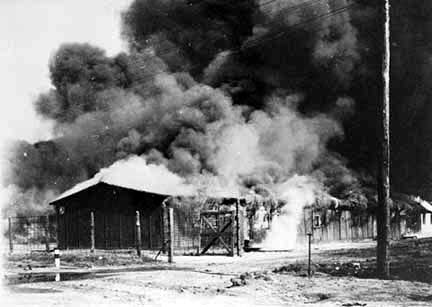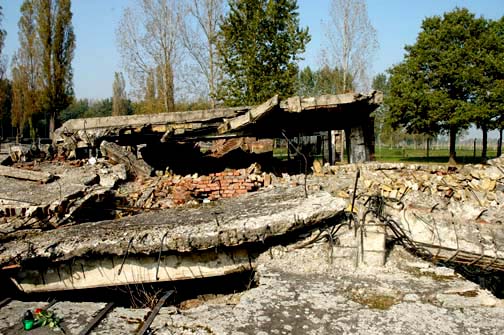A news article in The Times of Israel tells about a new memorial in Tel Aviv, which is shown in the photo below:

Pink Triangle Monument to gays and lesbians in Tel Aviv
Tel Aviv unveils memorial to gay Holocaust victims
Landmark is the first in Israel to deal universally with Jewish and non-Jewish individuals persecuted by the Nazis
TEL AVIV — Israel’s cultural and financial capital has unveiled a memorial honoring gays and lesbians persecuted by the Nazis during World War II.
Authorities in Tel Aviv unveiled the memorial Friday. It shows a pink triangle — the symbol gays were forced to wear in concentration camps. Writing on it in English, Hebrew and German reads: “In memory of those persecuted by the Nazi regime for their sexual orientation and gender identity.”
Did those hateful Nazis actually persecute innocent men and women for their “sexual orientation and gender identify”? NO! They persecuted criminals who broke the German law, known as Paragraph 175, which had been on the books since 1871 when the German states were first united into a country. Many other countries, including the United States of America, had similar laws which made homosexual acts a crime.
Did the evil Nazis go around peeking through bedroom windows to find men who were breaking the law known as Paragraph 175? NO! They arrested men who were having gay sex in public, in bathhouses and on stage in night clubs. As far as I know, women were not arrested in Germany, nor in any other country, for being lesbians.
The main concentration camp, where homosexual men were sent, was Sachsenhausen, the camp in Oranienburg, near Berlin. When I visited the Sachsenhausen Memorial Site in 1999, I picked up an Information Leaflet, which told about the Klinkerwerk [brick works], which was a satellite camp of Sachsenhausen.
According to the leaflet, the Klinkerwerk satellite camp was used for “… the deliberate annihilation of certain prisoners groups.”
“From July to September 1942, the systematically planned murders of some 180 to 200 homosexual prisoners were carried out in the Klinkerwerk satellite camp.” according to the Information Leaflet.
As the closest concentration camp to Berlin, Sachsenhausen had more homosexual prisoners than any of the other camps. A total of approximately 10,000 homosexuals were sent to all the Nazi concentration camps combined during the 12 years of the Third Reich, according to a display which I saw in the Holocaust Museum in Washington, DC. in the year 2000.
In an era when homosexuals were still in the closet in all the countries of the world, Berlin was a mecca for gays. The movie Cabaret depicts the gay scene in Berlin before the Nazis came to power. It was based on a book entitled Goodbye to Berlin by Christopher Isherwood, who lived an openly gay lifestyle in Berlin, the capital city of Germany.
After the Nazis came to power in Germany in 1933, male homosexuals who broke the German law, by flaunting their lifestyle in public, were arrested. After their second arrest and the completion of their second prison term, homosexual men were sent to a concentration camp for six months. As far as I know, no lesbians were ever sent to a concentration camp, solely for being a lesbian.
Some of the young men, who were sent to Sachsenhausen after they had been imprisoned for public homosexual activity, were actually Strichjunge, or male prostitutes, from Berlin.
This quote is from the memoirs of Rudolf Höss:
The strict camp life and the hard work quickly reeducated this type [ male prostitutes]. Most of them worked very hard and took great care not to get into trouble so that they could be released as soon as possible. They also avoided associating with those afflicted with this depravity and wanted to make it known that they had nothing to do with homosexuals. In this way countless rehabilitated young men could be released without having a relapse.
In 1943 the brick factory [Klinkerwerk] was partly converted into an armament factory where hand grenades were produced. On April 10, 1945, an Allied bombing raid destroyed the armament factory and the brick factory. About 200 prisoners of the concentration camp lost their lives in the raid.
Homosexuals were also sent to Dachau, but when the Dachau camp was converted into a Memorial Site, they were not honored.

Pink triangle memorial in the Dachau Museum
Notice the pick triangle on the right in the photograph above, taken at Dachau in 2003. At the bottom of the plaque, the words read “To the homosexual victims of National Socialism, the homosexual initiatives of Munich, 1985.” The inscription at the top reads “Beaten to death, killed again by silence.”
The inscription on the triangle refers to the fact that homosexuals in all the Nazi concentration camps received very harsh treatment from their fellow prisoners, and after the war, the homosexuals were not included in the commemoration of the victims. The pink triangle at Dachau was first placed, in a small room, inside the Museum on June 18, 1995.
In the early days of the Dachau camp, the Kapos, who supervised the other prisoners, were German criminals, who typically treated the homosexuals very badly. Later the internal administration of the Dachau camp was taken over by the Communist inmates, who did not honor the homosexuals.
After the war, it was the Communists who designed and supervised the Dachau Memorial Site, which was set up in 1965. There is no pink triangle on the bas relief sculpture at the International Monument at Dachau, and also no green triangle in honor of the German criminals. The new 2003 Dachau museum included both the homosexuals and the German criminals as victims of the Nazis.
This quote from the news article in The Times of Israel explains why the city of Tel Aviv was chosen for a memorial to the gays and lesbians, who were persecuted by the Nazis:
The landmark joins similar memorials in Amsterdam, Berlin, San Francisco and Sydney dedicated to gay victims of the Holocaust. While Israel has scores of Holocaust monuments, the Tel Aviv memorial is the first that deals universally with Jewish and non-Jewish victims alike.
“This will be the first and only memorial site in Israel to mention the victims of the Nazis who were persecuted for anything other than being Jewish,” Lev told Haaretz. “As a cosmopolitan city and an international gay center, Tel Aviv will offer a memorial site that is universal in its essence. As far as I’m concerned, it’s not a monument, but a place — a place of quiet that will invite visitors to sit, contemplate, reflect and be in solitude.”
Tel Aviv has a vibrant gay scene and is a top international destination for gay tourists.
Many Germans referred to Hitler’s Germany as a paradise. Hitler tried to clean up the country. The YouTube video below is from the movie Cabaret.
















